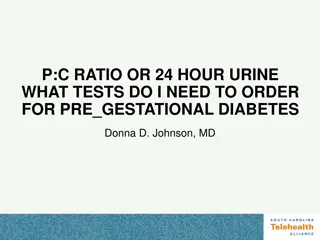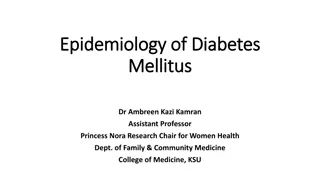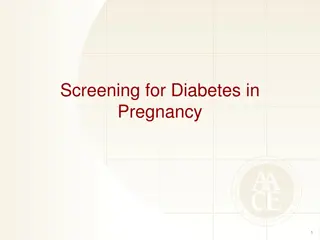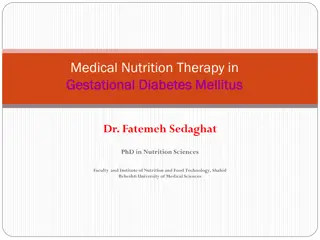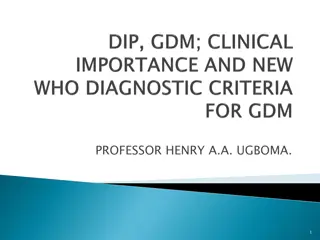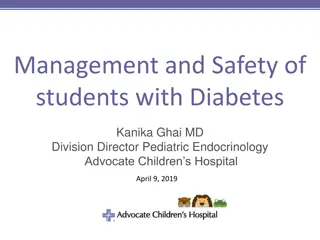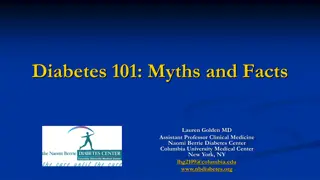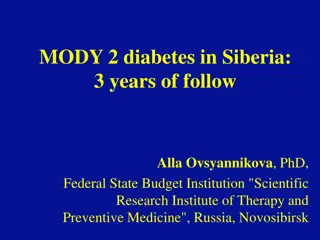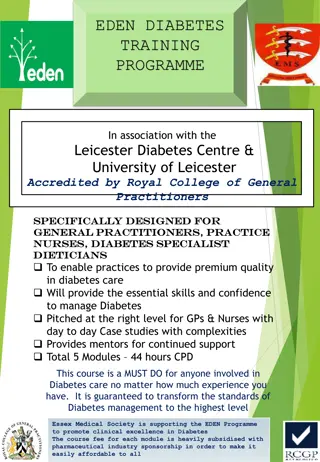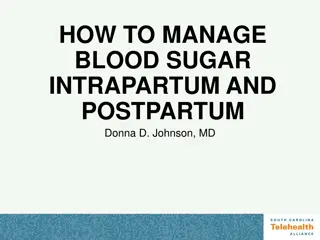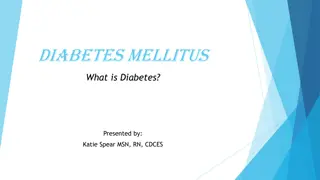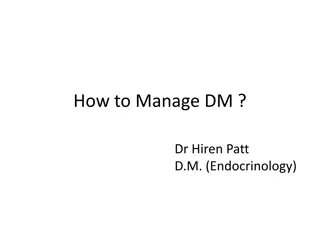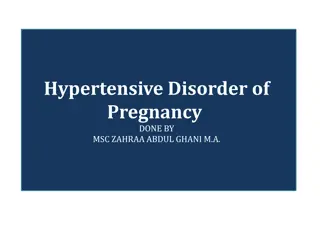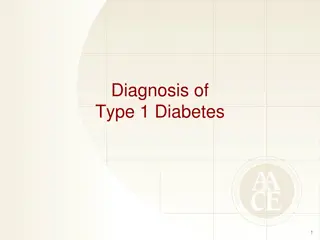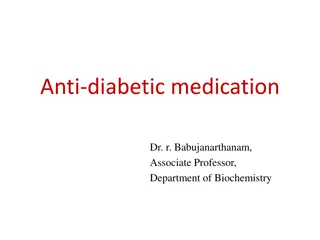Understanding Gestational Diabetes: Risk Factors, Diagnosis, and Management
Gestational diabetes is a condition where high blood sugar levels develop during pregnancy in women without pre-existing diabetes. Risk factors include maternal age, family history of diabetes, ethnicity, and obesity. Diagnostic tests involve measuring blood glucose levels, and management includes a healthy diet, insulin therapy, and self-monitoring. Complications can affect the baby with growth abnormalities and increased risk of low blood glucose. Prevention strategies include moderate physical exercise and smoking cessation.
Download Presentation

Please find below an Image/Link to download the presentation.
The content on the website is provided AS IS for your information and personal use only. It may not be sold, licensed, or shared on other websites without obtaining consent from the author. Download presentation by click this link. If you encounter any issues during the download, it is possible that the publisher has removed the file from their server.
E N D
Presentation Transcript
Medical Science Faculty of Sagua la Grande, Villa Clara Subject: English VII and VIII Professors MSc.Julian Cairo Molinet, Assistant professor BA. Miguel S nchez G mez, Assistant professor
Gestational diabetes Objective: To describe different features of Gestational diabetes in order to prepare students to talk about the disease and discuss a case in English
Gestational diabetes also known as gestational diabetes mellitus (GDM), is a condition in which a woman without diabetes develops high blood sugar levels during pregnancy.
Risk factors Polycystic Ovary Syndrome A previous diagnosis of gestational diabetes or prediabetes, impaired glucose tolerance, or impaired fasting glycaemia A family history revealing a first-degree relative with type 2 diabetes Maternal age a woman's risk factor increases as she gets older (especially for women over 35 years of age). Ethnicity (those with higher risk factors include African-Americans, Afro- Caribbeans, Native Americans, Hispanics, Pacific Islanders, and people originating from South Asia) Being overweight, obese or severely obese A previous pregnancy which resulted in a child with a macrosomia Previous poor obstetric history
Diagnostic tests / Lab tests Non-challenge blood glucose tests (measuring glucose levels in blood samples without challenging the subject with glucose solutions) A blood glucose level (fasting, 2 hours after a meal, or simply at any random time) Challenge test (drinking a glucose solution and measuring glucose concentration) Screening glucose challenge test (O'Sullivan test) Oral glucose tolerance test Urinary glucose testing
Prevention Moderate physical exercise during pregnancy Smoking cessation
Management Healthy diet Insulin therapy Counselling before pregnancy Self monitoring of blood glucose levels
Complication On the baby Growth abnormalities Chemical imbalances after birth. Risk of being both large for gestational age (macrosomic). Increased risk of low blood glucose (hypoglycemia), jaundice, high red blood cell mass (polycythemia) and low blood calcium (hypocalcemia) and magnesium (hypomagnesemia). Untreated GDM also interferes with maturation, causing dysmature babies prone to respiratory distress syndrome due to incomplete lung maturation and impaired surfactant synthesis.
After studying this condition, write a paragraph answering the following questions. ( See also Useful Phrases Document). Send the text to: juliancm@infomed.sld.cu What is Gestational Diabetes? What are the main signs and symptoms? Who is at risk of this condition? How is it diagnosed? What is the differential diagnosis? What are the possible complications? What does the treatment include? What is the prognosis?
Useful phrases to give information about a medical condition Concept is defined/known as .. is Classification -The classification of ..includes . is classified into is the classification of .. -Signs and Symptoms -The most common signs and symptoms of _____include .. _____,_____,___and_____ are the most common signs and symptoms Risk factors -Risk factors for include -People with are at a higher risk for developing -In patients with a long history of is highly probable to suffer ________, _______, and________ are the main risk factors for developing ______
Diagnostic procedures/Exams and investigation/Lab tests The main diagnostic procedures/Exams and investigation/Lab tests for HBP are/include: ________,_____-and_________. HBP can by diagnosed by ___________,_______,and________. ________, _________, ________ and________are the main diagnostic procedures/Exams and investigation/Lab tests for HBP
Differential diagnosis The possibility of __________should not be excluded. ___________ is a very likely/ highly probable/ diagnosis. __________ can cause pain of similar severity and radiation, but _________ is ruled out in this case because The differential diagnoses are/include __________ and __________. Treatment/ management The treatment (for this condition) include The treatment (for this condition) is based on _____________ is the best treatment for this condition The treatment consists on_________
Prognosis The prognosis is good / poor / guarded / bad / reserved. The prognosis is good if the patient follows the treatment. Complication The complications of HBP are mainly The most common complication(s) is/ are Other complications associated with HBP include _________,________, and ________ are the most common complication of HBP .are well-recognized complications of the first episodes of HBP
Bibliography 1. Abbot, G. The Teaching of English as an International Language: A Practical Guide. La Habana: Editorial Revolucionaria; 1989. 2. Agnes, M. (Editor-in-chief) Webster s New World College Dictionary. 4th edition: New York: Macmillan; 1999. 3. Ballinger, Ph. Merrill s Atlas of Radiographic Positions and Radiologic Procedures. 8th Edition: Mosby; 1995. 4. Bates, B. Guide to Physical Examination and History Taking. 8th edition New York: Lippincott Williams & Wilkins; 2003. 5._______________. English through Medicine Two. Student s Book. Editorial Ciencias M dicas; 2007. 6._______________. English through Medicine Two. Teacher s Book. Editorial Ciencias M dicas; 2007. 7. Colectivo de Autores. English for Professional Nursing Communication. Student s Book. La Habana: Editorial Ciencias M dicas; 2004. 8. _______________ English for Professional Nursing Communication. Teacher s Book. La Habana: Editorial Ciencias M dicas; 2004.


